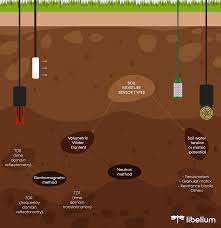In this article we are going to examine soil moisture, which is a direct consequence of infiltration process. The discussion will center on the definition and importance of soil moisture, factors affecting soil moisture, and measurement of soil moisture.
Definition and Importance of Soil Moisture
Soil moisture or soil water as it is referred to in some quarters, is normally considered to include both the water contained in the soil profile itself and the subsurface water in the unsaturated subsoil layers between the soil profile and the water table.
Thus defined, soil moisture includes all the water in the zone of aeration which may extend tens or even hundreds of metres below the ground surface. However, the ability of the shallow soil profile proper to absorb and retain moisture is generally of great hydrological importance (Ward and Robinson 2000).
Water in the soil is a critical resource needed for plant growth. The amount of water available at any given time is determined by the soil water balance, which includes the gain, loss, and storage of soil water.
Water held in storage in the soil water zone is increased by recharge during precipitation but decreased by use through evapotranspiration. Surplus water is disposed of by downward percolation to the ground water zone or by overland flow.
Soil moisture storage is a “savings account” of water that can receive deposits and allow withdrawals as conditions change in the water balance. Soil moisture storage refers to the amount of water that is stored in the soil and is accessible to plant roots.
Moisture retained in the soil comprises two classes of water, only one of which is accessible to plants. The inaccessible class is hydroscopic water, the thin molecular layer that is tightly bound to each soil particle by the natural hydrogen bonding of water molecules.

Such water exists even in the desert but is not available to meet moisture demands. Soil is said to be at the wilting point when all that is left in the soil is unextractable water; the plant wilt and eventually die after a prolonged period of such moisture stress.
The soil moisture that is generally accessible to plant roots is capillary water, held in the soil by surface tension and hydrogen bonding between the water and the soil.
Most capillary water that remains in the soil is available water in soil-moisture storage and is removable to meet moisture demands through the action of plant roots and surface evaporation.
After water drains from the larger pore spaces, the available water remaining for plants is termed field capacity, or soil-storage capacity. Generally, maintaining soil moisture close of field capacity is essential to plant growing success.
When soil becomes saturated after rainfall or snowmelt, some soil-water surplus becomes gravitational water. This excess water percolates downward under the influence of gravity from the shallower capillary zone to the deeper groundwater zone.
Plant roots exert a tensional force on soil moisture to absorb it. As water transpires through the leaves, a pressure gradient is established throughout the plant, thus “pulling” water into plant roots. When soil moisture is at field capacity, plants obtain water with less effort.
As the soil water is reduced by soil-moisture utilization, the plants must exert greater effort to extract the same amount of moisture. As a result, even though a small amount of water may remain in the soil, plants may be unable to exert enough pressure to utilize it.
The unsatisfied demand is a deficit (Christopherson, 2007). Rainwater, snowmelt, and irrigation water provide soil moisture recharge.
Measurement of Soil Moisture
Soil moisture measurements are made in a variety of ways but the principal method employed is the gravimetric method. In that procedure, a soil sample is weighed and placed in a container of known weight.
Read Also : Soil Conservation: Meaning, Categories and Soil Management Practices
The weight of the wet soil sample is thus known. The soil sample is sealed in its container and taken to a laboratory where it is removed and over dried at 1050C, until all the water evaporates.
The sample is then weighed again, and the loss in weight is equated to the weight, and thus the amount of soil moisture that the field sample contained.
A number of other methods for determining soil moisture include radiological, electric resistance, remote sensing amongst others. Details of these methods are available in literature.

